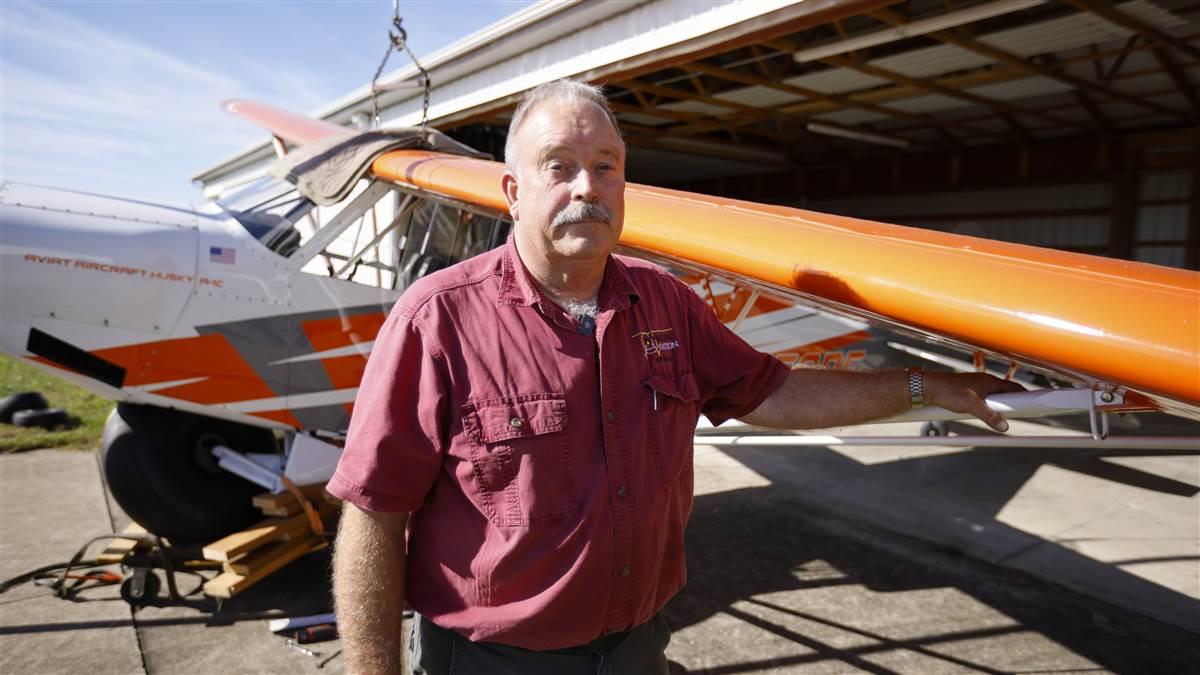Unexpected road trip
AOPA Sweeps Husky transported to Aviat after ground incident
The AOPA Sweepstakes Aviat Husky departed Frederick, Maryland, on July 18 en route to EAA AirVenture Oshkosh, but unfortunately, it did not make it to the show. Upon landing at its first fuel stop—Carroll County Airport (TSO) in Carrollton, Ohio—the airplane was involved in a ground loop, resulting in damage to its left wing tip and landing gear.

Although the wing and landing gear can be repaired, we decided to transport the airplane to Aviat Aircraft where a brand-new wing and landing gear would be installed. When the AOPA Sweepstakes airplane is awarded to the winner next year, it will be as good as new.
Aviat recommended that AOPA contact Whisler Aviation, which has been retrieving and transporting Aviat Huskys since 1997. A&P/IA Greg Whisler and his wife, Terri, have transported so many Huskys, they’ve even created a custom trailer for the job. At 48 feet long and able to haul two aircraft at the same time, the trailer contains all the tools and supplies needed to safely transport Husky and Pitts aircraft to the Aviat factory for repair. Whisler Aviation also transports a wide range of piston and turbine aircraft (including helicopters) for insurance companies, maintenance facilities, the military, and museums.
The process
Whisler has been fine-tuning their process for many years, and only two people are needed to retrieve a Husky. If the landing gear is damaged, as was the case with AOPA’s Husky, the process begins by lifting the aircraft by its lift rings using a custom-made hoist attached to the back of a truck. Whisler cuts the Husky’s landing gear bungee cords, disconnects the brake line, removes the damaged landing gear, and replaces it with an unairworthy one he carries in the truck. The temporary landing gear fits in place perfectly, confirming the airframe mounting points are undamaged. To ease ground handling, the monster 31-inch tires are removed and replaced with tiny-looking 6.00-6 tires.
Next, the horizontal stabilizer and elevators must be removed since their width exceeds 8 feet, 6 inches—the maximum width allowed on trailers without a special permit. The flying surfaces are carefully laid on moving blankets to prevent paint damage or fabric punctures. Whisler and his associate meticulously place every nut and bolt into prelabeled bags to aid in the reassembly of the airplane.
Then the process of removing the wings begins. Fuel is drained from each wing tank and poured into a 150-gallon fuel tank cleverly fitted between the frame rails of the trailer. Trim pieces are removed; aileron cables, flap pushrods, pitot tubes, and electrical wire connectors are disconnected; the clear plastic fuel gauge tubes and fuel lines are cut; and the wings are ready for removal.


Loading and transporting
Whisler attaches a custom-made steel cradle to the hoist. The cradle lifts the wing at its midpoint so that the wing can be unbolted from the fuselage and guided to the trailer by one person while the other drives the truck. On this day, Whisler has more help than usual, and several of us move the wing to the trailer where it is bolted and strapped to a custom-made steel wing rack system that attaches to the outer edges of the trailer.
Now it’s time to load the fuselage. We roll it to the trailer, hook the hoist to the lift rings, and scoop the airplane onto the flatbed. Although the fuselage can fit between the wings (which is how Whisler Aviation can transport two aircraft on the trailer), we place the airframe aft of the wings, and Whisler secures the propeller and rudder so they remain immobile at highway speeds up to 75 miles per hour. Whisler says the propeller will start windmilling if it’s not secured.
Whisler’s most important tool? Knowledge. During the nine-hour disassembly and loading process, he repeatedly pointed out ways aircraft can be damaged during transport if those doing the work don’t know what to look for—or avoid. Broken wing ribs, bent ailerons, punctured fabric, scratched windows, nicked props, misplaced parts, and many other mistakes can add up to thousands—or tens of thousands—of dollars of additional expense beyond the cost to repair the initial damage.
The following day, Whisler texted a photo of the AOPA sweepstakes airplane sitting in front of the Aviat Husky authorized service center at Middleton Municipal Airport/Morey Field (C29) in Middleton, Wisconsin. Mission accomplished.
Matt Hofeldt, Aviat’s vice president of brand, called to say the airplane was in good condition with no additional damage incurred during transport. Even better, Hofeldt confirmed the Aviat factory in Afton, Wyoming, had finished building and painting the new wing and landing gear and they would soon be shipped to Middleton to install on AOPA’s Husky. Stay tuned, the AOPA Sweepstakes Aviat Husky will be flying again soon. 



